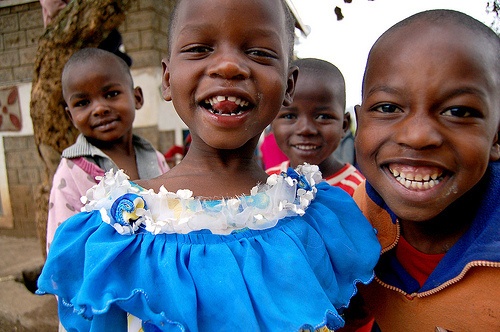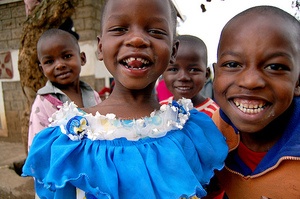

After children were paralyzed by a meningitis vaccine, the vaccine manufacturer changed information about how the vaccine is supposed to be handled on their website.
Millions of children across Africa have been included in meningitis vaccine trials, many without parental consent. VacTruth recently revealed this information, resulting in many agencies desperately trying to cover up this travesty and the sacking of two leading heads of state.
Shortly after VacTruth published the first of three articles covering the MenAfriVac vaccine tragedy in which dozens of children were paralyzed, in Gouro, Chad, in northern Africa, the prime minister of Chad, Emmanuel Nadingar, was relieved of his duties and replaced by the former chief of cabinet, Djimrangar Dadnadji. According to an excellent article by the human rights organization Ecoterra International, this abrupt change in leadership was ordered by Chad’s president Idris Déby, a patron of the anti-meningitis campaign. [1]
BIG NAMES, BIG MISTAKE
On January 13, 2013, VacTruth published the second of the three articles. By this time, Chadian authorities had reported that a total of 38 children who were suffering from adverse reactions to the vaccine had been evacuated to hospitals in N’Djamena, Chad’s capital. [2]
A few weeks later, VacTruth was informed that the health minister of Chad, Mamouth Nahor N’Gawara, had also been relieved of his duties and replaced by Dr. Mahamat Ahmat Djidda. [3]
So, why the sudden changes in leadership? It may have had something to do with the fact that VacTruth had reported the conflicting views from involved organizations on whether or not the MenAfriVac vaccine could be used outside of the usual controlled temperature chain (CTC) of 2 – 8 °C.
The organizations involved with the promotion of the vaccine had stated that MenAfriVac was a vaccine specifically designed to meet the needs of Africa’s meningitis belt, which stretches across sub-Saharan Africa. These organizations stated that the vaccine could be kept in a controlled temperature chain (CTC) at temperatures of up to 40°C for up to four days without the need for ice packs or refrigeration.
The organizations involved in the promotion of this information were the CDC, FDA, BMGF, PATH, MVP, WHO and UNICEF. (For meanings of these acronyms, please refer to key at the end of this article.)
[adrotate banner=”9″]
YOU WON’T BELIEVE WHAT HAPPENED NEXT
Of course this information would have been fantastic news for Africa, except for one vital point: at the time we published our articles, Serum Institute of India, the manufacturer of the vaccine, was promoting conflicting information. They had stated on their website:
“MenAfriVac should be stored and transported between 2-8ºC. Protect from light. The diluent should be stored at 25°C. It is recommended to protect the reconstituted vaccine from direct sunlight. Do not exceed the expiry date stated on the external packaging.”
Here is a snapshot of the original page.
An archived snapshot of the vaccine manufacturer’s website show they changed information about the storage of the vaccine shortly after the children became paralyzed.
However, when this information was checked for verification last week, the recommendations for vaccine storage had mysteriously changed to the following statements:
“MenAfriVac should be stored and transported between 2-8ºC. Protect from light. The diluent should be stored at 25°C. It is recommended to protect the reconstituted vaccine from direct sunlight. Do not exceed the expiry date stated on the external packaging. Immediately prior to reconstitution the vaccine is stable and can be used when exposed up to 40ºC for period of 4 days provided the vaccine has not reached its expiry date and the vaccine vial monitor has not reached the discard point.” [4]
Why was this information suddenly changed, after the vaccine had already been stored and administered according to the previous guidelines? Was it because we reported that dozens of children were paralyzed and suffering other adverse reactions after receiving MenAfriVac? Was it because we reported that this vaccine was administered to third-world children before it was licensed?
In October 2012, WHO had stated:
“The session began with an introduction by Mr. Michel Zaffran, who highlighted the groundbreaking progress made with MenAfriVac®, which will be the first EPI vaccine licensed for use in a controlled temperature chain (CTC).
… This is the final review of the document by IPAC prior to the planned field testing during the MenAfriVac® campaign in Benin in November 2012, where one district will use the vaccine in a CTC. After the field testing has been conducted, the revised final guidance document will come back to IPAC for endorsement in 2013.” [5]
The reasons why the manufacturer suddenly changed their recommendations for storage and transport remain a mystery. However, this new controversy still does not take away the fact that MenAfriVac was not licensed to travel in a CTC of temperatures of up to 40°C at the time the children of Gouro were vaccinated.
THIS DOESN’T MAKE SENSE!
What exactly is a controlled temperature chain? If these vaccines do not need refrigeration or ice packs for up to four days, how does the word “controlled” come into the process? Surely, without ice packs or refrigeration, there is no controlled temperature chain.
MenAfriVac is an inactivated vaccine (a vaccine which does not use a live virus). Previously, according to the CDC guidelines for vaccine temperature and storage, inactivated vaccines needed refrigerator storage at temperatures between 35°F and 46°F (2°C to 8°C), with a desired average temperature of 40°F (5°C). (Note, that is 40°F not 40°C.) [6]
So, what makes the MenAfriVac vaccine so different from other vaccines, that it does not require refrigeration for up to four days?
Another important point to consider is the fact that temperatures across Africa can exceed 40°C. According to the website Weather Spark, the average weather for N’Djamena, Chad varies between 15°C and 41°C. Their temperatures are rarely below 12°C or above 44°C. This means that outdoor temperatures can reach 44°C in a typical year. [7] In fact, in June 2010, temperatures in Chad reached an all-time high of 47.6°C. [8]
MORE UNANSWERED QUESTIONS
This information leads me to ask the following questions:
If the outdoor temperatures can reach 44°C in a typical year and the MenAfriVac vaccine is traveling inside a vehicle which may not have air-conditioning, in a container without ice packs or refrigeration, then how do the vaccinators know the true temperature the vaccine has reached at any given time?
If the truck carrying the vaccines is traveling across Africa at the time that the outdoor temperatures rise above 40°C, does the team return to base and scrap that particular batch of vaccines?
Can both the vaccine and the diluents be kept at the same temperature?
I ask the third question because it is usual for the vaccine and the diluents to be kept at different temperatures in accordance with recommendations from the manufacturer and the CDC.
ANOTHER SUSPICIOUS TRIAL
Another interesting point to consider is this: at the time the MenAfriVac vaccine was being administered to the children in Gouro, it was being tested to see whether or not it was safe to be administered to children in temperatures of up to 40°C. Therefore, it is odd that the vaccinators chose to vaccinate the children at the time of year when temperatures are usually below 30°C.
The children of Gouro were not the only children being used in clinical trials for the MenAfriVac vaccine. Babies between the ages of 14 –18 weeks were also being used for clinical trials in Ghana.
According to the Meningitis Vaccine Project (MVP), a MenAfriVac phase 2 clinical trial was carried out in Ghana, testing the vaccine for use in the under-one age group. The trial was carried out over a four-year period from November 2008 to November 2012 at the Navrongo Health Research Center, Navrongo, Ghana. A total of 1,200 infants took part in the trial, aged between 14 to 18 weeks on enrollment. MVP stated:
“Study results: Preliminary results show that the vaccine is safe and highly immunogenic. Final results will be presented in a forthcoming scientific publication.” [9]
The MVP News Digest reported the following:
“Research to document an indication for MenAfriVac™ use in infancy (in under 1-year-olds) is progressing well and according to schedule. A database lock for PsA-TT-004 was completed on December 21. PsA-TT-004 is a Phase 2 study that evaluates the safety and immunogenicity of different dosages and schedules of the MenA conjugate vaccine in 1,200 healthy infants when administered concomitantly with EPI vaccines. The study is conducted at the Navrongo Health Research Centre in Ghana and is scheduled for completion in early 2013.” [10]
On February 4, 2013, Spy News Ghana stated that the research findings show that MenAfriVac is safe and can be given to children under one year old, providing long-term protection from Group-A meningococcal meningitis in this age group. [11]
CONCLUSION
Today, the latest news from Gouro is that 40 children remain paralyzed in hospitals in both Chad and Tunisia, and a further 56 remain ill in the village of Gouro. However, news from Ecoterra International on February 9, 2013, said that the new heath minister wants to send them back home to their ill-equipped village. [12]
Until our intervention, there had been no publicity about the serious vaccine injuries in Chad. However, since our articles were published, there has been a flurry of worldwide media attention, including an extremely biased report in the Guardian UK telling the world that MenAfriVac is a wonderful vaccine. Mind you, to be fair, as you will see from the article, The Bill and Melinda Gates Foundation, a well-known supporter of vaccination initiatives, funded this section of the Guardian. [13]
The whole debacle is one coverup after another. The Chadian government has not asked any independent experts to evaluate the safety and efficacy of the MenAfriVac campaign, stirring up anger among the citizens of Chad. They have been left to cope with extremely sick children, many of whom are still reported to be paralyzed and suffering from severe convulsions. The children need appropriate medical care and their parents deserve answers.
[contentbox headline=”Key” type=”normal”]
CDC – Centers for Disease Control
FDA – Food and Drug Administration
BMGF – The Bill and Melinda Gates Foundation
PATH – Program for Appropriate Technology in Health
MVP – Meningitis Vaccine Project
WHO – World Health Organization
UNICEF – United Nations International Children’s Emergency Funding
[/contentbox]
[contentbox headline=”References” type=”normal”] 1. http://www.tolerance.ca/Article.aspx?ID=157421&L=en
2. http://www.sante-tchad.org/Renforcer-les-ressources-humaines-en…
3. http://vactruth.com/2013/01/13/children-paralyzed-by-vaccine/
4. http://www.seruminstitute.com/content/products/product_menafrivac.htm
5. http://www.who.int/immunization_delivery/systems_policy/IPAC_2012_October_report.pdf
6. http://www.cdc.gov/vaccines/pubs/pinkbook/vac-storage.html#temperatures
7. http://weatherspark.com/averages/29142/N-Djamena-Chari-Baguirmi-Chad
8. http://www.treehugger.com/clean-technology/9-countries-have-recorded…
9. http://www.meningvax.org/clinical-004.php
10. http://www.meningvax.org/files/MVPnewsdigest_2010_Q4_27_EN.pdf
11. http://www.spyghana.com/research-shows-that-new-meningitis-vaccine-is-safe-for-children/
12. http://www.groundreport.com/World/Do-to-them-what-they-are-doing-to-you/2951229
13. http://www.guardian.co.uk/global-development/2013/feb/04/aid-vaccines…
[/contentbox]
